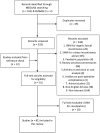Systematic review of the impact of sacral neuromodulation on clinical symptoms and gastrointestinal physiology
- PMID: 26245170
- PMCID: PMC5054906
- DOI: 10.1111/ans.13257
Systematic review of the impact of sacral neuromodulation on clinical symptoms and gastrointestinal physiology
Abstract
Background: Sacral neuromodulation (SNM) has emerged as a treatment option for faecal incontinence (FI). However, its objective effect on symptoms and anorectal function is inconsistently described. This study aimed to systematically review the impact of SNM on clinical symptoms and gastrointestinal physiology in patients with FI, including factors that may predict treatment outcome.
Methods: An electronic search of MEDLINE (1946-2014)/EMBASE database was performed in accordance with PRISMA guidelines. Articles that reported the relevant outcome measures following SNM were included. Clinical outcomes evaluated included: frequency of FI episodes, FI severity score and success rates. Its impact on anorectal and gastrointestinal physiology was also evaluated.
Results: Of 554 citations identified, data were extracted from 81 eligible studies. Meta-analysis of the data was precluded due to lack of a comparison group in most studies. After permanent SNM, 'perfect' continence was noted in 13-88% of patients. Most studies reported a reduction in weekly FI episodes (median difference of the mean -7.0 (range: -24.8 to -2.7)) and Wexner scores (median difference of the mean -9 (-14.9 to -6)). A trend towards improved resting and squeeze anal pressures and a reduction in rectal sensory volumes were noted. Studies failed to identify any consistent impact on other physiological parameters or clinicophysiological factors associated with success.
Conclusion: SNM improves clinical symptoms and reduces number of incontinence episodes and severity scores in patients with FI, in part by improving anorectal physiological function. However, intervention studies with standardized outcome measures and physiological techniques are required to robustly assess the physiological impact of SNM.
Keywords: anorectal physiology; faecal incontinence; sacral nerve stimulation; sacral neuromodulation.
© 2015 The Authors. ANZ Journal of Surgery published by Wiley Publishing Asia Pty Ltd on behalf of Royal Australasian College of Surgeons.
Figures
References
-
- Kalantar JS, Howell S, Talley NJ. Prevalence of faecal incontinence and associated risk factors; an underdiagnosed problem in the Australian community? Med. J. Aust. 2002; 176: 54–57. - PubMed
-
- Sharma A, Marshall RJ, Macmillan AK, Merrie AE, Reid P, Bissett IP. Determining levels of fecal incontinence in the community: a New Zealand cross‐sectional study. Dis. Colon Rectum 2011; 54: 1381–1387. - PubMed
-
- Johanson JF, Lafferty J. Epidemiology of fecal incontinence: the silent affliction. Am. J. Gastroenterol. 1996; 91: 33–36. - PubMed
-
- Brown HW, Wexner SD, Segall MM, Brezoczky KL, Lukacz ES. Quality of life impact in women with accidental bowel leakage. Int. J. Clin. Pract. 2012; 66: 1109–1116. - PubMed
Publication types
MeSH terms
LinkOut - more resources
Full Text Sources
Other Literature Sources
Molecular Biology Databases


